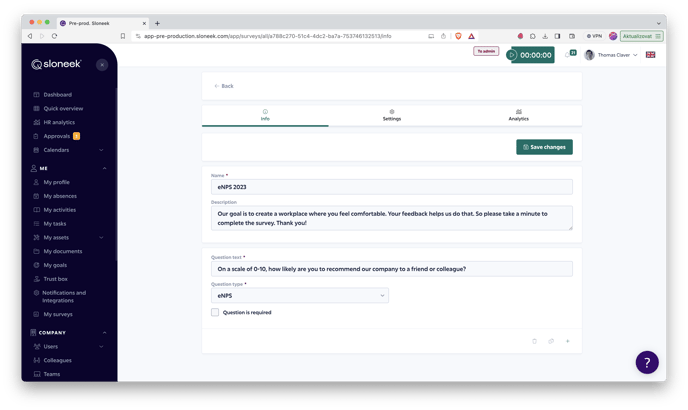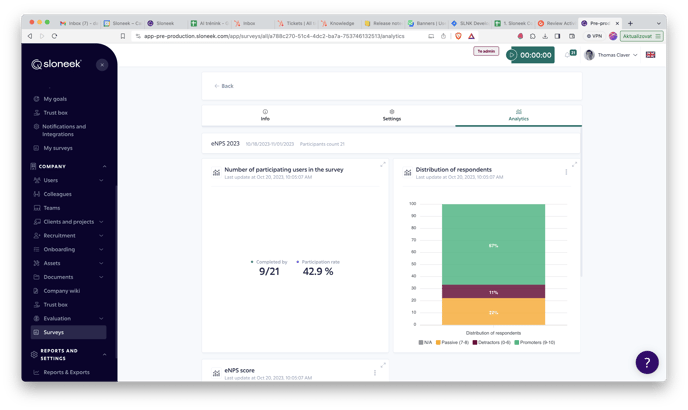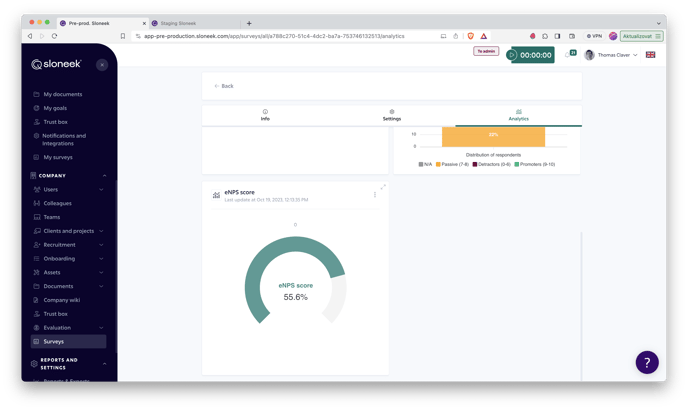Using eNPS metrics helps companies measure and track employee satisfaction, allowing them to respond quickly to issues and create a better work environment.
Contents:
| What is eNPS? | How to create eNPS? | How to read eNPS results? |
| Why is eNPS important? | How often to measure? |
What is eNPS?
eNPS is the acronym for Employee Net Promoter Score and is a metric used to assess employee satisfaction in an organization. Similar to the traditional Net Promoter Score (NPS), which is used to measure customer satisfaction, eNPS focuses on employee satisfaction.
How to create eNPS?
Creating an eNPS is not difficult. Employees are asked a simple question, usually phrased as: On a scale of 0 to 10, how likely are you to recommend this organization as an employer to your friends or colleagues?
Sloneek has an eNPS question type for this purpose. When you use it and ask the above question, just send the survey to your users and the system will do all the calculations for you.
TIP: To get more useful and detailed feedback from employees, we recommend including at least one or more additional questions in the survey to help you understand why the employee gave the grade they did.
This may include questions to describe the reason behind the given rating or open questions for employees` suggestions on the initiatives that would make them give higher rating.

How to read eNPS results?
Reading eNPS results is key to understanding where you stand on employee satisfaction. A good eNPS result depends on a variety of factors including company culture, industry specifications and other context.
You can find your eNPS results clearly in the survey details under the Analytics tab.

Based on the answers, employees are classified into three groups:
- Promoters (score 9-10): Employees who are satisfied and would likely recommend the organization.
- Passive(score 7-8): Employees who are more or less satisfied but may not be active advocates of the organization.
- Detractors (score 0-6): Employees who are not satisfied and would probably not recommend the organisation.
The eNPS score is calculated using a simple equation by subtracting the percentage of promoters from the percentage of detractors, dividing the result by the number of all respondents and multiplying by 100:

The eNPS value can be between -100 and +100, with higher values being better. A result between 10 and 30 can generally be considered a good result, values above 50 are excellent and values around 80 and above are among the best in the industry. Conversely, lower values (even negative ones) can indicate significant problems that should not be underestimated.
However, it's always best to also compare results to industry averages and track changes over time to better understand your organization's relative performance.

Why is eNPS important and how to process results?
The eNPS employee survey is important for several reasons. Among the most important are:
-
Quickly determine employee satisfaction: eNPS provides a simple and quick way to find out how satisfied employees are with their work and the organisation.
-
Predicting employee behaviour: Employees who are promoters are more likely to stay with the company and contribute to a positive company environment. Conversely, detractors can be a harbinger of problems such as employees leaving or spreading a negative reputation.
-
Incentive to change working conditions: eNPS can serve as an incentive to progress and improve working conditions, which can ultimately increase productivity and keep employees happy.
-
Competitiveness in the labour market: Organisations with high eNPS have an advantage in the labour market because they are more attractive to potential employees.
- Improved company-wide productivity: Employee experience is linked to employee performance, productivity and creativity. Businesses with high employee satisfaction tend to have higher productivity and higher profits.
How to increase eNPS?
- Talk to the detractors: Nobody likes criticism. Yet listening and responding to feedback from detractors makes a huge difference to your disgruntled employees and your company. Instead of viewing detractors as a problem, your disgruntled employees are a real opportunity for improvement.
- Avoid complacency: Avoiding complacency is essential to creating a positive feedback loop. It's important not to take high ratings from promoters for granted, but to still pay attention to them. Consistent appreciation and assistance support the employee experience.
- Be transparent: Data collection is only part of the solution. Sharing data is also essential. Transparency builds trust and allows for honest conversations. By being open, employees can propose their own solutions to the issues raised.
- Use eNPS for action, not measurement: he most important thing to conclude. Measuring eNPS for measurement's sake alone is not enough. Employees should see that there is a deeper reason behind it that provides the impetus for needed action and change. Only then will they respect and support the surveys.
How often to measure eNPS?
Measuring eNPS is not a one-off exercise. Its importance lies in tracking trends over time. But how often should you measure eNPS?
It is essential to strike the right balance. Measuring too often leads to survey fatigue, which can weaken employees' perception of its importance. However, if you measure eNPS irregularly or infrequently, you risk missing out on important insights and opportunities to improve the employee experience.
We recommend measuring eNPS at least quarterly or semi-annually. This frequency will allow you to capture trends and changes in employee sentiment over time and take timely action to address any issues.